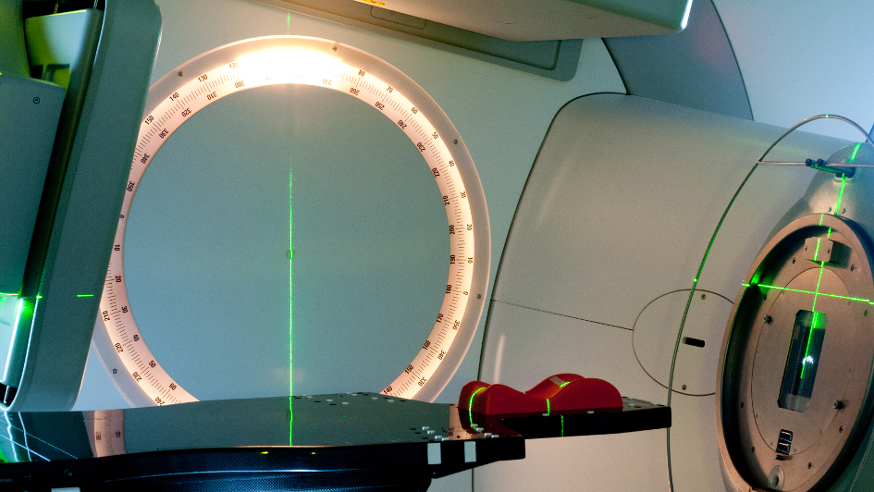
Image: Radiotherapy machine at The Royal Marsden
A new way to deliver radiotherapy that rotates patients in sync with the treatment beam could treat patients with brain cancer as accurately and quickly as the most advanced radiotherapy available, scientists at The Institute of Cancer Research, London show.
The treatment uses a technique called Dynamic Couch Rotation to carefully synchronise the position of patients with the motion of the radiation beam.
For five patients with brain cancer, researchers calculated the new technique was as accurate as advanced radiotherapy, called Volumetric Modulated Arc Therapy (VMAT).
Harmful or debilitating side effects could limit the benefit of radiotherapy treatment for patients with brain cancer, but the new technique can deliver effective doses of radiation while reducing exposure to sensitive brain tissue nearby, compared with VMAT.
The findings, published in the journal Physics in Medicine & Biology, could encourage the technique to be explored in clinical trials to improve radiotherapy treatment.
New method could deliver effective radiotherapy
Volumetric Modulated Arc Therapy (VMAT) is one of the most sophisticated forms of radiotherapy for patients with cancer, and was pioneered by scientists at the ICR and The Royal Marsden NHS Foundation Trust.
The system uses a moving gantry to deliver radiation, controlling the angle and shape of the beam, and the rate of the dose delivered to patients’ tumours, to provide the most accurate form of treatment available.
Dynamic Couch Rotation (DCR) improves on VMAT by moving patients simultaneously with the treatment gantry moving around them, to offer radiotherapy that is even more beneficial.
Researchers at the ICR and The Royal Marsden simulated radiotherapy treatment plans using DCR for five patients with brain cancer, which they found were as accurate as VMAT delivered radiotherapy.
Research at the ICR is underpinned by generous contributions from our supporters. You can contribute to our mission to make the discoveries to defeat cancer.
Radiotherapy using DCR can deliver treatment quickly and on the same systems as VMAT, with minimal changes to their setup.
DCR could also reduce the risks of side effects from advanced radiotherapy techniques by exposing sensitive organs near tumours to smaller doses of radiation, compared with VMAT.
The study was funded by the NIHR Biomedical Research Centre at The Royal Marsden and the ICR, with additional support from Cancer Research UK.
Steer radiation more effectively around critical tissues
Study author, Dr James Bedford, Leader of the Radiotherapy Treatment Planning team at the ICR, said:
“Advanced radiotherapy equipment moves around patients to focus radiation on tumours while minimising damage to healthy tissue, but it is difficult to avoid irradiating sensitive normal structures around the tumour. This can lead to side effects, and sometimes it is necessary to compromise the dose to the tumour to limit these side effects.
“Our study shows that by moving patients at the same time as the treatment gantry, we can steer the radiation beam more effectively around the critical tissues. This new type of radiotherapy could minimise side-effects while delivering effective treatment to the tumour.
“Dynamic couch rotation radiotherapy could be particularly effective for patients with diseases like brain cancer, and can be delivered using only small modifications to standard radiotherapy equipment.”
